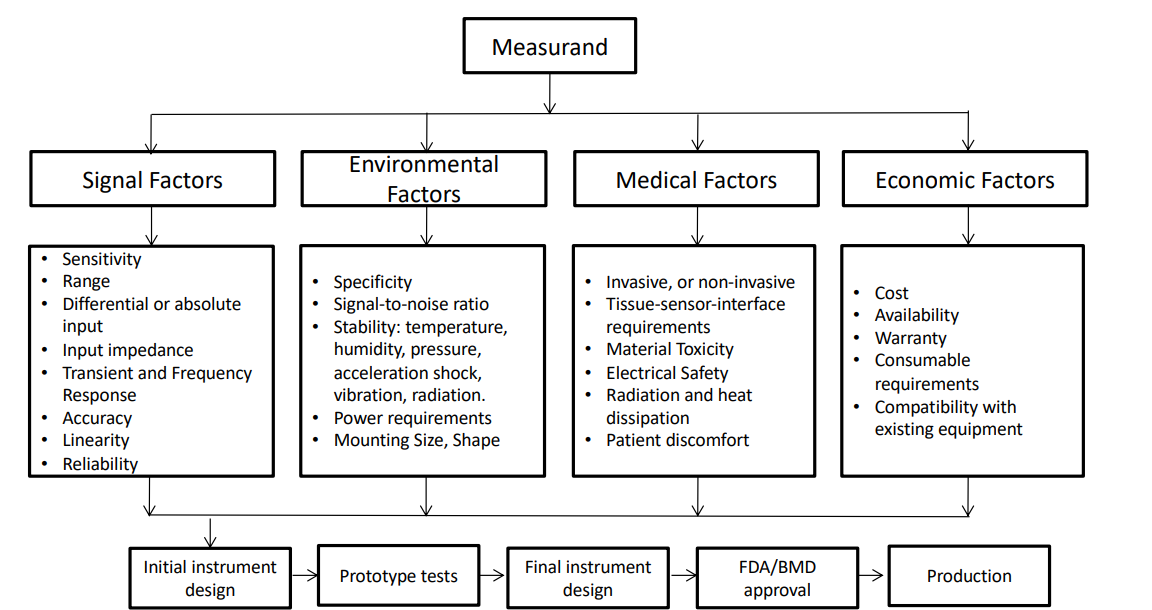- Have Revised
Application of Biomedical Electronics¶
Monitoring - of biological / physical signals e.g heart rate, glucose, etc...
Diagnosing - certain conditions e.g DNA mutators, cardiac arrhythmia
Replacing - biological function e.g artificial organs, limbs
Stimulating - certain organs e.g deep brain stimulation, pace maker
Must-haves:¶
- Unobtrusive - Small in size and easy to use
- Ultra-low power consumption - Long battery life
- 24/7 monitoring / local processing - Immediate response for critical conditions
- Wireless - Transparent to user, autonomous
- Low cost - Disposable, mass deployment
Biomedical Electronic Systems¶
Now lets have a look at a general system...

• Measurand – The physical quantity, property or condition that the system measures. eg. bi-potentials, chemical concentrations, pressure, displacement.
• Sensor – Transduces energy from one form to another. Conveys physical measurand to an electrical output. e.g pH/glucose sensor, accelerometer, ECG instrumentation.
• Signal Conditioning – Treat the signal for to enhance detection, further processing and communication. e.g Amplification, Filtering, Analogue to digital conversion
• Auxiliary Elements – Calibration signal with the properties of the measurand. Can elicit the measurand, adjust sensor and signal conditioning blocks. e.g Dynamic range adjustment, resolution.
• Feedback – Application of stimulus, electrical/chemical to the body. Can be either a result of a trend in the measurand or a time-based therapy. e.g Electrical stimulation, Drug infusion.
• Data Transmission – Transmit the information from the body/device for further use. e.g Wireless, wired to a screen.
Design Considerations for Medical Devices¶

Types of Medical Electronics¶
Bench Tops:
- Diagnose a sample after extraction
- Used in dedicated labs
- e.g DNA sequencing, blood gas analysers, ultrasound
Handheld Electronics:
- Small scale diagnostic / monitoring machine
- Portable
- e.g blood glucose meters, point-of-care diagnostic devices
Lab-On-Chip:
- Typically uses semiconductors integrated with micro-fluidics to analuse samples on the small scale
- Can achieve mass integration via large scale sensing arrays
- e.g DNA sequencing
Wearable Electronics:
- Typically worn on body and monitors a specific condition or vital sign
- Needs to be unobtrusive
- e.g heart rate monitor, blood oxygen reader (oximeter), etc
Injestable / Swallowable Electronics:
- Transient implant capable of monitoring, imaging and delivering drugs
- Due to size constraints, power is sent inductively
- e.g Pill cameras, chemical sensors
Implanatable Electronics:
- Typical for long-term to monitor / stimulate for a chronic condition
- Invasive procedure required
- Typically rechargable battery
- e.g pace makers, neural probes, etc...
Note
Should have a battery life cycle of more than 100 years
Prosthetics:
- Artificial device extension that replaces a missing body part
- Can be implanted
- Typically coupled with sensory information